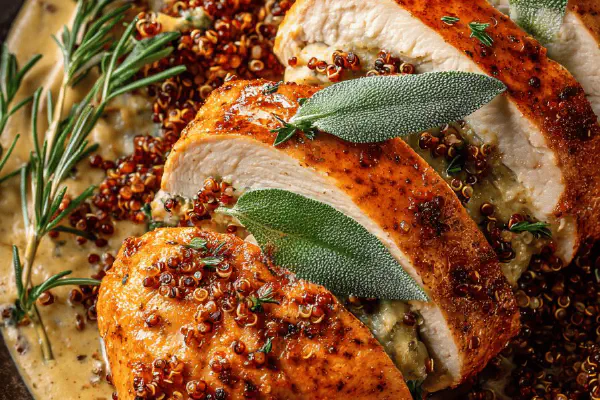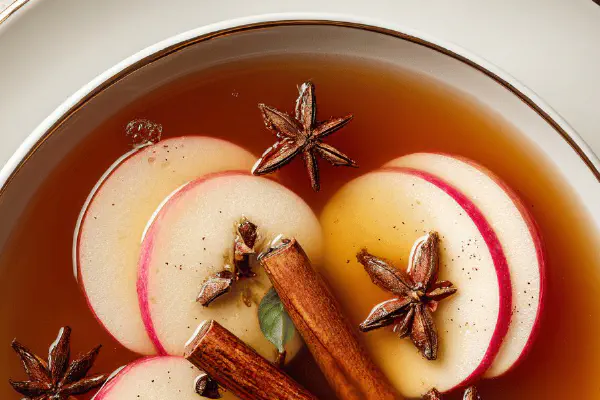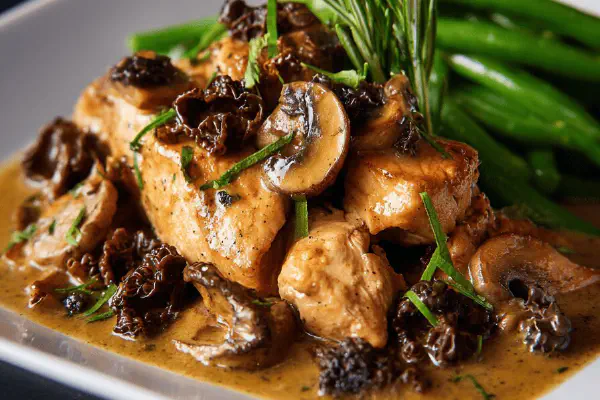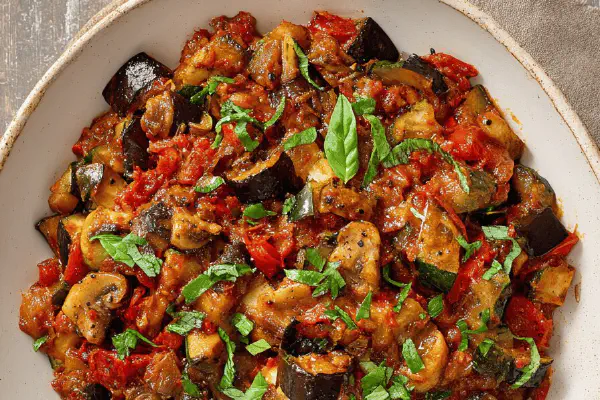Turkey Rolls Quinoa Pumpkin Sauce

By Emma
Certified Culinary Professional
Ingredients
SAUCE
- 375 ml (1 1/2 cups) kabocha squash peeled diced
- 1 small shallot minced
- 2 garlic cloves crushed
- 15 ml (1 tbsp) olive oil
- 500 ml (2 cups) chicken broth or vegetable broth
- 30 ml (2 tbsp) grainy mustard
- 5 fresh sage leaves finely chopped
- Salt pepper
FILLING
- 180 ml (3/4 cup) diced white leek
- 5 ml (1 tsp) fresh thyme chopped
- 30 ml (2 tbsp) olive oil
- 170 ml (about 2/3 cup) chicken broth
- 45 ml (3 tbsp) quinoa rinsed
- 1 pinch ground cinnamon
- 1 pinch ground nutmeg
- 45 ml (3 tbsp) chopped dried apricots
- 4 turkey escalopes (150 g - 5 oz each)
About the ingredients
Method
FILLING
- Heat olive oil over medium low. Softer leek and thyme fragrant, sweat gently but do not brown; 4-5 minutes. Add broth, quinoa, cinnamon, nutmeg; bring to simmer. Cover, reduce heat low, gently bubble till quinoa swells and liquid absorbed; about 18-20 min. Check texture: no crunch, not mushy. Stir in apricots while still warm. Let cool while prepping sauce and turkey.
SAUCE
- Warm olive oil over medium. Add squash, shallot, garlic. Stir often; softening and aromatic around 7 min. Add chicken broth and sage. Simmer, uncovered till squash yields easily to fork and broth reduces slightly; roughly 22-25 min. Blend in batches to a glossy puree; add grainy mustard last for punch. Season with salt, pepper. Keep warm. If sauce too thick, add splash broth.
TURKEY
- Oven rack middle; preheat to 185°C (365°F). Two turkey escalopes at once between plastic wrap. Pound with rolling pin thin and even - 20 x 15 cm approx. Remove top plastic. Salt and pepper lightly. Spoon half filling along wider edge; shape into tight rolls about 20 cm long, 4 cm thick. Remove bottom plastic and transfer carefully to large sheet heavy aluminum foil. Wrap tightly, twist ends like candy wrappers. Arrange on baking sheet.
- Repeat with remaining two escalopes.
- Roast wrapped rolls 50 minutes minimum. Look for slight firmness but juicy to touch. Remove foil, roast exposed 5-7 min for extra browning and drying edges (watch closely; dries quickly). Rest rolls 5 minutes before slicing to keep juices locked.
- Cut gently into thick disks with sharp serrated knife, serve hot with robust pumpkin-mustard sauce spooned over. Garnish optional: fresh thyme sprigs or microgreens.
TIPS & TROUBLESHOOTING
- Do not skip cooling quinoa filling before stuffing or turkey will shrink unevenly during roasting, causing tears. Quinoa cooked perfectly when grains slightly translucent and tails visible. Mushy filling means too much broth; dry means insufficient cooking or broth.
- If you get a bit of bitter from kabocha, balance with extra apricots or a drizzle of honey in sauce. Can swap dried apricots with chopped dried figs or cherries. Garlic can burn fast; watch and stir frequently.
- Pounding key: too thick hides filling flavor; too thin rolls tear. Use firm but gentle pressure. Foil wrapping seals moisture and traps steam, guaranteeing tender turkey without drying.
- Sauce blending crucial. Any fibrous bits ruin texture; test before seasoning. Mustard added post-blend to avoid bitterness and preserve punch.
- Elevate dish with side of wilted spinach or roasted baby potatoes tossed in rosemary and garlic.
- Leftover turkey rolls? Slice cold, serve on mixed salad leaves with mustard vinaigrette.
- Visual cues dominate timing: squash softens to fork tender; turkey rolls plump, not shriveled; quinoa fluffy but not wet. Smell garlic and thyme to know when to move to next step.
Cooking tips
Chef's notes
- 💡 Sweat leek gently over medium low heat; must soften without browning. Brown means bitter and ruins filling. Stir but no rush. Fragrance builds slowly. Quinoa simmers low till grains swell and liquid absorbed. Test texture often - no crunch, no mush. Add dried apricots while warm, they soften but don’t dissolve. Cooling filling before stuffing stops turkey shrinking unevenly, keeps rolls tight. Timing and texture more than clocks here.
- 💡 Olive oil heat medium for sauce; garlic moves constantly else burns bitter. Shallots soften, squash tender about 22-25min simmer uncovered, broth reduces a bit. Blend in batches, texture glossy not stringy. Grainy mustard last, stirred cold keeps flavor punchy, not bitter or cooked off. Season salt pepper gradually after each stage, layering flavors, not one big splash.
- 💡 Turkey pounded thin but even: roughly 20 by 15 cm. Rolling pin with plastic wrap top and bottom keeps clean and smooth surface. Salt and pepper lightly before spreading filling; too thick means tear risk when rolling. Shape tight rolls lengthwise, about 20cm long. Wrap foil candy wrapper style ends tight, traps steam. Roast covered 50 min for juiciness, then unwrap 5-7 min for browning edges, watch closely or dries fast. Rest 5 minutes to settle juices before slicing.
- 💡 If kabocha not found, sweet potato or pumpkin can substitute; avoid watery vegetables, puree fails if too wet. Dried apricots balance spice and add chew. Figs or finely chopped tart cherries also work, slightly different sweet notes. Must rinse quinoa well, saponin bitterness otherwise noticeable. Use fresh sage in sauce for herbaceous brightness instead of only thyme, deepens aroma. Broth can be chicken or vegetable depending on diet or preference.
- 💡 Pounding too hard tears rolls; too soft means loose filling spills. Use firm but gentle pressure. Wrap foil seals moisture, steam cooks evenly. Resting turkey keeps slices intact, no juice loss cutting hot. Blend sauce smooth, no fibrous bits – texture ruins mouthfeel. Reheat sauce with small splash broth if thickens; no cream or milk to keep dairy free intact. Watch garlic scent and thyme aroma for timing cues all through cooking.
Common questions
How do I avoid bitter quinoa?
Rinse quinoa well with cold water, rub grains under running flow. Saponin coating causes bitterness. Also simmer quinoa covered on low, slow bubbles, no scorching. Don’t over-stir, breaks grains, releases bitter notes.
Can I swap kabocha for other veggies?
Yes but pick sweet dense squash or root. Sweet potato or pumpkin works fine if firm. Avoid watery types; puree too thin and watery ruins sauce texture. Taste changes too; kabocha richer. Adjust cooking time based on vegetable softness.
My turkey rolls tear or filling falls out. Why?
Rolls too thick or pounding inconsistent. Use plastic wrap to pound evenly thin, about 1/4 inch thick. Fillings must cool first to prevent moisture loss. Roll tight but don’t overstuff. Foil wrap tight prevents drying and holds shape.
How to store leftovers safely?
Cool quickly, wrap tight in foil or airtight containers. Refrigerate up to 3 days. Reheat gently in oven wrapped to keep moisture; microwave dries edges fast. Sauce separately reheated with splash broth keeps texture. Freeze if needed but slice before freezing best for even reheating.



